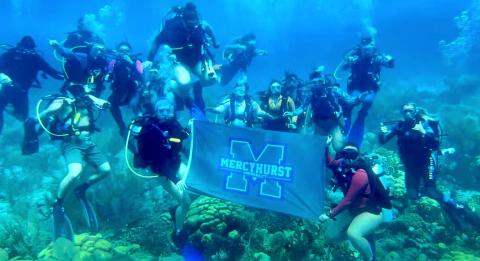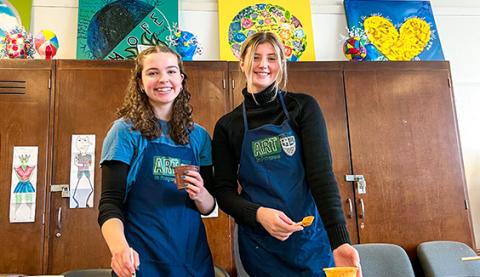Graphic Design
A state-of-the-art, two private graphics labs for a total of 35 MAC computers, Adobe Creative Cloud Design software, GoPro cameras, and a Printorium with 3D printers, large format printing, and a vinyl cutter — all the tools and high-tech gadgets our majors need to produce high-quality work to attract the attention of leading employers in the industry. It doesn’t hurt that our comprehensive curriculum integrates web and print design, which fosters versatile graduates. When students get to apply that knowledge in consultations with actual clients, they’re not only providing a tangible service within the community, but they’re also building robust professional portfolios. There’s no question — our graduates are well prepared for the workforce. This is evident in the number of jobs our graduates snag with high-profile corporate companies, such as Buffalo Bills, New Era, PNC, and EXPRESS.
Fast Facts
- Mercyhurst's Graphic Design program was ranked #4 nationwide by College Choice for 2020.
- What better way to learn about art than to experience it firsthand? That’s why graphic design majors regularly design for real clients, such as Community Resources for Independence (CRI), Chroma Guild, and the Icebreaker Tourney.

- The Art Department purchased its first 3D MakerBot printer in 2016. Several courses incorporate 3D printing to bring student designs to life.
- AdPro is a student-run, social organization that helps students better understand design, while practicing professionalism.
- The Digital Video Editing course is often paired with a faculty-led study abroad trip [FSAT]. Students take the Science of SCUBA for credit and certification. Then they pack their GoPros, traveling to Bon Aire for diving and video experiences.
- ACCT 101: Principles of Accounting (Three credits)
- MGMT 120: Principles of Management (Three credits)
- MKTG 162: Principles of Marketing (Three credits)
- DANC 200: Introduction to Arts Administration (Three credits)
- DANC 475: Arts Management Internship (Three credits)
- ART 128: Graphic Design Basics (Three credits)
- COM 240: Digital Video Production (Three credits)
- COM 260: Introduction to Social Media (Three credits)
- ART 321: Introduction to Website Design (Three credits)
- COM 312: Communication & Social Responsibility (Three credits)
- COM 314: Global Communications (Three credits)
- COM 330: Web & Social Media Analytics & Strategies (Three credits) Requires COM 260 to be taken previously or concurrently.
- Art 100: Drawing I (Three credits)
- Art 122 or 123: Art History (Three credits)
- Art 125: Two-Dimensional Design (Three credits)
- Art 126: Three-Dimensional Design (Three credits)
- Basic Level Two-Dimensional Studio (Three credits)
- Basic Level Three-Dimensional Studio (Three credits)
- Art Electives (Two) (Three credits)
- ART 122: Ancient to Medieval Art History (Three credits)
- ART 123: Renaissance to 20th Century Art History (Three credits)
- ART 128: Basic Computer Design (Three credits)
- ART 223: History of Modern Art (Three credits)
- ART 224: History of Photography (Three credits)
- ART 230: Graphic Design History (Three credits)
- ID 220: History of Interior Design (Three credits)
- ID 221: History of Architecture (Three credits)
- ARTH 125: Art Therapy I (Three credits)
- ARTH 225: Art Therapy II (Three credits)
- ARTH 325: Art Therapy III (Three credits)
- PSYC 101: Introduction to Psychology (Three credits)
- Three approved electives (Three credits)
- COM 101: Communication in Society (Three credits) Mass Media
- COM 102: Interpersonal Communication (Three credits)
- COM 260: Introduction to Social Media (Three credits)
- Students must take three additional courses within the Communication Department, two of which must be 300-level or higher.
- ARTH 125: Introduction to Expressive Therapies (Three credits)
- PSYC 101: Introduction to Psychology (Three credits)
- One developmental psychology course (Three credits):
- PSYC 241: Developmental Psychology: Childhood,
- PSYC 242: Developmental Psychology: Adolescence, or
- PSYC 142: Lifespan Development
- Abnormal Psychology (Three credits)
- COM 210: Mindful Communication (Three credits), ARTH 275: Group Practices (Three credits), or SOC 204: Cultural Differences (Three credits)
- And a least two courses in creative fields or modalities with prefixes ART, ARTH, THEA, DANC, MUS (Six credits) (At least one should be a 200-level or higher)
- ART 128: Basic Computer Design (Three credits)
- ART 220: Typographic Foundations (Three credits)
- ART 221: Digital Imagery (Three credits)
- Four approved Art and Graphic Design electives
- ART 106: Photography I
- ART 128: Basic Computer Design
- ART 206: Intermediate Photography
- ART 223: History of Modern Art
- ART 224: History of Photography
- ART 305: Digital Photography
- ART 306: Color Photography
- ART 400: Individualized Studio I
- ART 128: Graphic Design Basics (Three credits)
- COM 260: Introduction to Social Media (Three credits)
- ART 221: Digital Imagery (Three credits)
- ART 321: Introduction to Website Design (Three credits)
- ART 225: Computer Illustration Technology (Three credits)
- ART 325: Intermediate Website Design (Three credits)
- ART 326: Advanced Website Design (Three credits)
OR - COM 202: Contemporary Media Literacy (Three credits)
- COM 240: Digital Media Production I (Three credits)
- COM 330: Social Media Management (Three credits)
- THEA 110: Acting I (Three credits)
- THEA 245: Script Analysis: From Page to Stage (Three credits)
- THEA 290: Topics in Theatre History (Three credits)
- THEA 401: Practicum (Three credits)
Consists of 21 credits as follows:
Two electives of the following, at least one 300-level course.
Required Courses
Course Choices (Nine credits)
Minors (unless permitted by the department chair) are not able to take COM 390: Professional Development or COM 473/475: Internship.
Students who are majors may pursue the Minor Electives Cluster in Website Design in the Art Department. In contrast, Graphic Design majors may pursue the Minor Electives Cluster in Communication.
Required Courses
Minor Electives Cluster
Choose two: If courses in the minor cluster are required for your major, please take the opposite cluster.
Learning Outcomes
- Present, critique, and write about works of art and design using appropriate terminology from history, culture, and contemporary art and design.
- Generate works that demonstrate a productive creative process and exhibit a high level of craftsmanship and technical facility.
- Develop artworks that use elements and principles of art and design.
In the Classroom

The Mercyhurst University Department of Art, Design, and Communication teamed up with the Erie Zoo for an “ExZOOberant Paint Party” in our art studio. The Jungle Crayon Fence surrounds the children’s play area as a memorable and fun piece of personality in the nearby Erie Zoo. Students and faculty from the Department of Art, Design, and Communication led the initiative to host a painting party to give new life to this iconic fence in the zoo area. The entire Mercyhurst community was invited to join in the fun, with students, faculty, and staff helping paint more than 85 crayons with unique designs and names that all adhered to an animal theme. Mercyhurst’s Department of Art, Design and Communication students love opportunities to be creative in the Erie community, especially the chance to work on unique displays like the Jungle Crayon Fence!
It can be. Your advisor will discuss individually the strengths and weaknesses of different minors. To be up to this discussion, look up the minor in your catalog. Look at ALL the courses required. It is not necessary to MINOR. Often it is recommend to those unsure to take a smattering of other courses in marketing, public relations, technical writing, television production, philosophy, world cultures, etc. There are so many areas to explore and all will teach you critical reasoning, the language of a field, and how to work with others and clients.
Yes, you do. High school provides a broad general understanding of a topic. In college, you are developing a critical mindset that will take the information from each course and build on that information. In your major, this connection is especially important. Students come from diverse background with varied experience in the making of Art. Some of you will understand basic terminology. Other will not. What the foundation year does is establish a common base line for performance in the Art Department at Mercyhurst University. At Mercyhurst there will be requirements and expectations that are based on you carrying knowledge from 2-D design into Graphic Design, from Graphic Design into Photography, from Art History into Painting, etc. These connections and concepts are what you are learning to adapt and embrace. When you graduate and work in the field of art these skills are what employers expect you to know and understand. When you cut corners, revert to old habits, make assumptions that you already know how to do something, you set yourself up for difficulties within the discipline of Art and Design. That is not to say forget what you have learned before. It is to say, “Be flexible.” The more you are open to new ideas, as well as the traditions of the field, the better you will be as an artist. Art is in a state of constant growth and experimentation.
If you follow the requirements in the catalog and student handbook, pass all your courses, and have a GPA above 2.5, it is absolutely possible to graduate in four years.
There are many projects, clubs, and work-study positions that would employ your artistic skills.
For publication experience, explore Lumen and the Yearbook. At the end of sophomore year you are prepared to apply to work on the staff of these publications.
For work-study experiences that use design, there is Sport Information, the PAC, the Marketing Office, and the Graphics Lab. See Mrs. Hopper with questions about these.
For clubs, there is AdPro, the Student Advertising Club; the Art Club; and Student Activities Committee. AdPro leans more toward applied design/advertising. The Art Club sets it own agenda every year. The SAC usually has a group in charge of PR. Whatever your interest there is usually opportunity to join a club and help with the design.
Trips also provide outside experiences. Usually twice a year we travel to major art shows in the area. Take advantage of these really inexpensive ventures and sign-up when they are announced!
That is what advisement is all about. You have two advisors available to you, a general academic advisor and your “major” academic advisor. Your advisors want to help you answer academic questions, explore the opportunities, and help you make the connections you need. They are interested in you making choices that are right for you. You will meet with them in the fall, and every term from then on, to discuss how you are progressing toward your goals.
Your advisor reviewed your file, which includes your SAT/ACT scores, high school transcripts, sports considerations, and any other notes specific to you. That information, along with the college’s requirements, molded the choices that were made. As a first-term freshman, you are required to take: 2-D Design, Computer Design Basics, College Writing I, IMU (2c), an introductory course in your major, and one other course. Some advisors schedule five courses. Our philosophy is that your college education starts better with the highest GPA you can achieve. “College is a marathon, not a sprint.” You need to build a solid foundation with your early classes. Make friends and get involved. Thus, you have been set up for success with a five-class load.
Recommendations: Here’s a formula to get you started. For every hour in class, plan on two hours outside of class for homework. Example: a 2.5-hour art class = five hours of homework. Try planning your week on a chart in half-hour increments. Remember that most of your new friends will be around in the evening, making it harder to do reading and “quiet” homework. Time between classes is great for getting small tasks done, and late afternoon is great for homework.
| Emma Ratesic ’24 – CASA of Westmoreland | Chris Borzilleri ’11 – Creative Design Manager at NORESCO (PA) |
| Casandra Reese ’24 and Franci Titus ’22 (PB) – Erie Episcopal & the Episcopal Diocese of NWPA | Tiffany Cook '10 – Aspen Snowmass, Social Media and Events Marketing (CO) |
| Jessica Clark ’23 Associate, Design Operations and Ashley Favata ’16 Senior Graphic Designer – New Era Cap Company Headquarters | Mike Temple '09 – Amazon, Program Manager (SC) |
| Karley Livingston ’22 – Austin Peay State University | Kellie Cope Riley '08 (PB) – PNC, Lead UX Designer, Software (PA) |
| Savannah Cicciarelli ’21 – U.S. Department of Justice (WDC) | Gina Christofferson '07 – Senior Art Director, Creative Marketing at EXPRESS (OH) |
| Savannah Serafin ‘21, Grace Potzler ’20, Megan Hess ‘12 – Buffalo Bills | Ashley Casey '06 – Spotify, Web Designer (OH) |
| Samantha Sherwood ’21 – Digital & Creative Coordinator at WQLN PBS NPR (PA) | Frank Pessia ‘06 – Wegman's Corporate, Creative Area Manager (NY) |
| Jillian Marcellin ’20 – Graphic Design Duquesne University (PA) | Matthew Zehner '06 – Zehner Group, CEO (LA) |
| Adrienne Nannen ’20 – Marketing Strategist for Erie City Government (PA) | Dominic Aratari ’03 – Product Designer at Meta Reality Labs |
| Kelsey Elliot '14 – Moon Tide Media, Graphic Designer (LA) | Luke Pieczynski '03 – Creative Director & Experience Design Manager at PwC (PA) |
| Rose Heid '14, Isaac Smith ‘13, Samantha Ciprich ‘09, Kelly Hardner ’08, and Jeremy Hewitt '07 – Erie Insurance Group (PA) | Sarah Sampsel '03 – Work & Company, Design Director (NYC) |
| Erin McCandless ’12 – Digital Content Creator at AEK Solutions (PA) |
- ART 100 Drawing I (foundation year)
- ART 125 2-Dimensional Design (foundation year)
- ART 126 3-Dimensional Design (foundation year)
- ART 106 Photography I
- ART 122 or 123 Art History
- Two Approved Studio Offerings
This entry-level course introduces the student to the basics of Graphic Design. Through various exercises, students will experience three of the basic publishing tools used by designers - Adobe InDesign, Illustrator, and Photoshop.
This entry-level course introduces students to basic design theories and skills. Students create a variety of exercises and a portfolio of professional works to better understand design. Theoretical exercises, typography projects, readings, and client projects introduce students to lifelong design issues and tasks. Adobe InDesign, Illustrator, Photoshop, After Effects, and Dimension are utilized in this course.
Photoshop image creation and manipulation is explored. Emphasis, in this term, is proper file creation, learning and utilizing specialized tools, applying proper design theories to computer generated art, and tutorials for special effects. Projects focus on various kinds of photo collage and retouching as it relates to a variety of clients. Prerequisite: ART 220.
This course is an introduction to digital video editing. Students will be working in the style of non-linear video editing. The tool of choice will be Final Cut Pro X / MAC OS platform. Projects will follow a workflow of idea generation, scripting, storyboarding, media collection, media organization, storyline building, addition of text / titles, stills, audio and finally export / publishing. Final projects will be uploaded and published via website and YouTube (DVD publish optional). Furthermore students will create projects that utilize basic camera shots and angles. Video shooting will incorporate foundational cinematography techniques. Mini projects will demonstrate movie-making techniques of Alfred Hitchcock, Pudovkin and other classic movie makers. As a camera operator students will properly setup an interview, frame a shot and conduct an interview. Project concepts will include, but not be limited to documentary, Ken Burns, Time-lapse, Lyric video, different video with song, Procedural, Mercyhurst PSA and Commercials.
This class expands student’s command of Adobe Illustrator by exploring a combination of vector skills, traditional media and techniques used to create spot and editorial illustration. Assignments may include: children’s book illustration, card and gift design, editorial illustration, portraiture and icon systems. Prerequisite: ART 220.
Beginning with the Industrial Revolution, this course will chart the development of what we contemporarily refer to as Graphic Design and Advertising. Students will survey the designers, works, technologies, and philosophies of the major design movements and create work exploring these areas. Emphasis will be placed on the connection of design to art and popular culture, as well as the cyclical nature of design. Students create various pieces reflecting the work of the movements being studied. Prerequisite: ART 220.
Multi-page layout is the emphasis in this class. Students learn how to handle text, integrate images into layout, and develop a keener sense of typography. Projects may include: magazine layout, cook book layout, CD design, brochure design and book jacket design. Students will learn how to use Adobe InDesign and the digital publishing suite. Prerequisite: ART 221.
This class introduces students to design for the World Wide Web. Students add Dreamweaver to their software arsenal. An emphasis on a design ideology using HTML and CSS to solve visual problems is used in order to create sites based on industry standard practices. Current issues specific to the World Wide Web are introduced. Sites are mapped. A selection of pages are created and uploaded to remote servers. Prerequisite: ART 221.
The most intensive of all the design courses, students in this course create and design for two companies - an imaginary company of their own choosing and a local small business through the Small Business Development Center. Logotypes are designed. Brand sensing is applied. Advertising is focused. Packaging and Graphic Design Standards are developed. Prerequisite: ART 320.
The culmination of a student’s graphic design efforts, this course seeks to refine a student’s style and to display it in the most advantageous form. Students create a traditional and online portfolio. Students are required to commit to a geographical area and discipline focus. With this decision made, research is performed, cover letters generated, resumes refined, and the job hunt begins. Prerequisites: 6 approved graphic design courses.
This course builds upon the HTML5 / CSS3 skills from previous courses. Students add to their base of skills to take the presentation of the web page to the world of responsive frameworks. Using industry accepted responsive frameworks web pages will properly display on mobile, tablet and desktop devices. CSS skills are also honed to give better color, type, layout and interactivity to the produced websites. Prerequisite: ART 321.
This course will take students to advanced levels of experience with current CMS (content management systems). The CMS experience will take the designer from start to final delivery of a professional grade CMS solution. These steps include: server side software installation, configuration, user control, theme and plug-in application, page and post creation and finally theme development. The final CMS skill will be the application and testing of an e-commerce module with a working payment gateway. Prerequisite: ART325.
- Fonts: You will have “trouble” with fonts. They are not cross platform.
- Commands: Keyboard commands will be different. You will be instructed on the Mac. You will need to be able to translate the keyboard command to PC. Hint: Control=Command and Option= Alt. This will take care of some of the issues.
- Viruses: You will be downloading items like crazy! You will need to keep up religiously on your virus software. Macs do not have nearly as much trouble in this area.
- Troubleshooting: We may be able to help you troubleshoot a problem with an Adobe application or a file. We ask that you take notes when we provide you guidance because these problems often repeat! The IT Help Desk can assist with many hardware problems.
- Job Field: Macs are entrenched in Graphic Design and K-12 Education. If you don’t learn the Mac now, when? You will eventually need to be familiar. Consider it part of your training.
- Digital Cameras: Students are required to have a DSLR camera that has manual controls, aperture, and shutter speed, as well as manual focus.
- Portable Hard Drives: Pick up a 2 TB WD Elements portable hard drive to back up your work. You will have a copy of your work on your computer, in the cloud, and on your hard drive. That way if something crashes you will have a back-up — if you take the time to periodically save to those resources.
- USB Drives: these are to only be used to transfer, print, or trade work. Do NOT use them as a back-up device. They break too easily.
If you have a working computer already, use that until you are sure of your major! You will have the use of the Graphic Lab and programs for your homework. Often students wait until Sophomore Review to invest in their Macs and Adobe software. Then, you can buy the kind of computer and programs you need.
The IT Help Desk will recommend a PC to general students. You are not a general student. Graphic Design Students work primarily on Apple Macintosh. There is a student link that will review the platform options with you. We recommend high-end laptops for their flexibility and longevity. Macs with a newer system already have the higher end hardware by default that would be able to receive future updates for the operating system as well. You will need a minimum of 1 gig front side cache to run Adobe Creative Cloud. If you must get a PC, 8 GB of RAM and 512 GB SSD is the minimum. The rest of the specs are up to you. Obviously, the higher end unit that you buy, the longer, for either system, it will last.
You can work the design applications on PC. You will have some issues that will be yours to solve:
Applications can be purchased for Mac or PC. Software titles upgrade almost yearly. Adobe has the Creative Cloud that allows you to lease the programs from Adobe for $19.99 a month with a year commitment. This allows you to receive all upgrades as they come out. And they come out multiple times in a year.
Peter Stadtmueller, M.S.
Program Director, Graphic Design
Office: Hirt 100A
Meet the Faculty
Art, Design, and Communication







